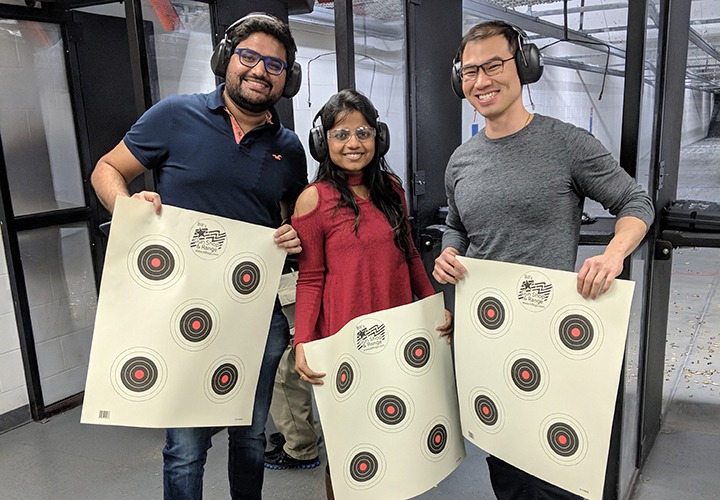 Back to News
Back to News
May 7, 2025
Court-Shopping for Biased Benches Nothing New to Firearm Industry
Court watchers scratching their heads over the legal scrum concerning illegal immigration are learning what the firearm industry has known for years. There are judges who will engage in legal gymnastics to arrive at a preferred result.
Media have been reporting on the ongoing debate of whether federal district court judges can issue sweeping decisions that affect policy across the entire nation. Even U.S. Sen. Chuck Grassley (R-Iowa), Chairman of the Senate Judiciary Committee, has weighed in on the ongoing tensions surrounding the separation of powers between the three co-equal branches of government – the Executive, Legislative and Judicial Branches. Each is designed to hold the others in check, ensuring that the government isn’t run by fiat from just one branch.
None of this is new to the firearm industry. For decades, firearm industry members have been caught in that ongoing tension between those who write the laws, those who enforce the laws and those who decide if those laws are aligned with the U.S. Constitution.
Take for instance, the recent decision by the U.S. Court of Appeals for the Ninth Circuit in Duncan v. Bonta. The court decided in a 7-4 en banc decision that California’s ban on standard capacity magazines did not violate the Constitution because it decided that magazines are not “arms” protected under the Second Amendment, they’re mere “accoutrements” despite being essential to the proper functioning of a semiautomatic firearm.
Judge Patrick Bumatay’s dissenting opinion noted that a correct application of the Bruen framework shows that since “the plain text of the Second Amendment protects the possession of magazines capable of feeding more than ten rounds, California’s ban is presumptively unconstitutional.” Likewise, he explained that California failed to overcome the presumption of unconstitutionality because it did not identify a historical analogue that was relevantly similar to California’s law, which “strictly bans the ownership, possession, and use of magazines in common use today.” Accordingly, he would hold that California’s magazine ban is unconstitutional.
Defying Precedents
Judge Bumatay wrote in his dissent that the 9th Circuit majority got it wrong in their opinion to uphold California’s magazine ban and remand the case back to the district court. He wrote that the 9th Circuit was failing to apply the U.S. Constitution as interpreted by the U.S. Supreme Court.
“But, as federal judges, our duty is to uphold the Constitution – no matter how unpopular. After all, the right to keep and bear arms is a ‘fundamental right necessary to our system of ordered liberty.’” Judge Bumatay disputed, adding later, “So while California seeks to limit its citizens’ access to firearms – even with the best of intentions – it is our duty to ensure that the Second Amendment endures and that this ancient right of the people is given its fullest breadth. Otherwise, we abdicate our role to the whims of the political majority of the State.”
Judge Bumatay is clearly concerned the judiciary should not become a rubber stamp for the political winds and popular sentiment among the legislative branch. The laws that are drafted by the legislative branch, and executed by the executive branch, must comport with the foundational bedrock rights that belong to “the People” and not the government. They must also comport with Supreme Court precedent. That’s where Judge Bumatay pointed out that the 9th Circuit’s majority got it wrong.
“Nothing in the historical understanding of the Second Amendment warrants California’s magazine ban,” Judge Bumatay wrote, adding, “Thus, neither the text of the Second Amendment nor our country’s historical tradition of firearm regulation supports California’s magazine ban. Still, the majority once again upholds California’s regulation. In doing so, the majority defies the Supreme Court.”
Judge Bumatay pointed out the majority opinion’s folly in declaring that magazines aren’t “arms” protected by the Second Amendment, which he called an “extreme position.”
“Such a belief displays ignorance of both firearms operations and constitutional law,” he wrote.
Judge Bumatay pointed out the majority’s decision that magazines aren’t “arms” fails because it was passed on a portion of a district court opinion that was unanimously reversed by the U.S. Court of Appeals for the District of Columbia. He also noted that no other circuit court has gone out on a limb as far as to declare magazines aren’t “arms.”
‘More Nuanced Approach’
It’s not just an unwillingness to abide by established court precedents that frustrates the firearm industry when gun control advocates use the courts to advance policy agendas. It’s also some courts’ willingness to take novel approaches and engage in sophistry to arrive at their decisions. But the 9th Circuit majority acknowledged in the majority opinion that this approach won the day in Duncan.
“We readily conclude that a more nuanced approach is appropriate here. This case implicates both unprecedented societal concerns and dramatic technological changes,” wrote Judge Susan Graber for the Duncan v. Bonta majority opinion. She contended that the U.S. Supreme Court’s Bruen decision called for such an approach. “But, because the Court did not flesh out how the ‘more nuanced approach’ operates – for instance, whether more recent analogies should be consulted – we have taken the most conservative path in our analysis by declining to apply the more nuanced approach.”
Judge Ryan Nelson, siding with the minority, disagreed with that tact in his own dissenting opinion.
“But the majority didn’t just butcher the Second Amendment and give a judicial middle finger to the Supreme Court. It also spurned statutory procedure for en banc proceedings,” Judge Nelson wrote.
He pointed out that the 9th Circuit lacked the statutory authority to decide the appeal, which it previously remanded to a lower court. In essence, he argued that the judges that previously spurned a lower court’s decision should not have been presiding over the subsequent appeal.
“Never before has a court allowed five senior judges to control an en banc decision on behalf of the court’s active judges,” he wrote. “We shouldn’t have been the first, let alone in such an important case.”
Nothing New
None of this is entirely new. Even Supreme Court Justice Clarence Thomas expressed his frustrations with lower courts defying precedent and ignoring the Second Amendment’s plain text. In the Bruen majority opinion, which Justice Thomas authored, he wrote, “When the Second Amendment’s plain text covers an individual’s conduct, the Constitution presumptively protects that conduct,” continuing, “The constitutional right to bear arms in public for self-defense is not a second-class right, subject to an entirely different body of rules than the other Bill of Rights guarantees. We know of no other constitutional right that an individual may exercise only after demonstrating to government officers some special need.”
Further, in the Bruen decision, Justice Thomas admonished lower courts for attempting to continue to use two part “means-end” or “balancing-interest” tests, which were already denounced by the Supreme Court in the Heller decision.
“The Court rejects that two-part approach as having one step too many. Step one is broadly consistent with Heller, which demands a test rooted in the Second Amendment’s text, as informed by history,” Justice Thomas wrote. “But Heller and McDonald do not support a second step that applies means-end scrutiny in the Second Amendment context. Heller’s methodology centered on constitutional text and history. It did not invoke any means-end test such as strict or intermediate scrutiny, and it expressly rejected any interest-balancing inquiry akin to intermediate scrutiny.”
The reality is that some courts are known for antipathy toward Second Amendment rights. The 9th Circuit is just one. The U.S. Court of Appeals for the First Circuit is another – the same court that revived Mexico’s frivolous $10 billion lawsuit against firearm manufacturers for the crimes committed by narco-terrorist drug cartels, in Smith & Wesson Brands, Inc., v. Estados Unidos Mexicanos, which the Supreme Court heard arguments on earlier this year.
That’s why NSSF continues to support legal arguments advancing the position that laws governing the firearm industry must be aligned with rights protected by the U.S. Constitution.
You may also be interested in:
U.S. Supreme Court Weighs Mexico’s Claims to Get Around PLCAA
N.Y. Lawmaker is California Dreaming of Flawed Gun Owner Liability Insurance Mandate
Categories: BP Item, Featured, Government Relations, Top Stories









